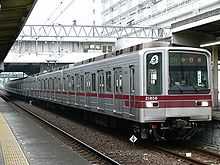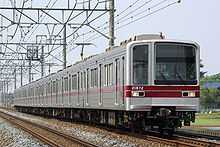Tobu 20000 series
| Tobu 20000 series | |
|---|---|
|
20000 series, June 2008 | |
| In service | 1988– |
| Manufacturer | Alna Kōki, Tokyu Car Corporation |
| Replaced | 2000 series |
| Constructed | 1988–1996 |
| Number in service | 192 vehicles (24 sets) |
| Formation | 8 cars per trainset |
| Operator | Tobu Railway |
| Depot(s) | Kasukabe |
| Line(s) served | Tobu Skytree Line, Tobu Nikko Line, Tokyo Metro Hibiya Line |
| Specifications | |
| Car body construction | Stainless steel |
| Car length | 18,000 mm (59 ft 1 in) |
| Width | 2,857 mm (9 ft 4.5 in) |
| Doors | 3/5 pairs per side |
| Maximum speed | 110 km/h (70 mph) |
| Acceleration | 3.3 km/h/s |
| Deceleration | 3.7 km/h/s (service), 4.5 km/h/s (emergency) |
| Electric system(s) | 1,500 V DC |
| Current collection method | Overhead line |
| Safety system(s) | Tobu ATS |
| Track gauge | 1,067 mm (3 ft 6 in) |
The Tobu 20000 series (東武20000系 Tōbu 20000-kei) is a commuter electric multiple unit (EMU) train type operated by the private railway operator Tobu Railway in Japan since 1988.[1]
Variants
- 20000 series: 13 x 8-car sets introduced from March 1988
- 20050 series: 8 x 8-car sets introduced from December 1992 with 5-door cars
- 20070 series: 3 x 8-car sets introduced from March 1997
20000 series
13 8-car sets (21801 to 21813) were built to replace the ageing 2000 series trains on inter-running services between the Tobu Skytree Line and the Tokyo Metro Hibiya Line in Tokyo, entering service on 25 March 1988. The body design uses a new lightweight corrugated stainless steel construction.[1]
Total number of vehicles built: 104[1]
Formation
| Designation | Tc1 | M1 | M2 | M1 | M3 | M1 | M4 | Tc2 |
|---|---|---|---|---|---|---|---|---|
| Numbering | 21800 | 22800 | 23800 | 24800 | 25800 | 26800 | 27800 | 28800 |
The M1 cars are each fitted with one scissors type pantograph.[2]
20050 series

Eight 8-car sets (21851 to 21858) were introduced on 29 December 1992 on Tobu Skytree Line and Tokyo Metro Hibiya Line inter-running services. These sets feature two 5-door cars at each end, and also LED destination indicators.[1]
Total number of vehicles built: 64[1]
Formation
| Designation | Tc3 | M5 | M2 | M7 | M3 | M7 | M6 | Tc4 |
|---|---|---|---|---|---|---|---|---|
| Numbering | 21850 | 22850 | 23850 | 24850 | 25850 | 26850 | 27850 | 28850 |
The M5 and M7 cars are each fitted with one scissors type pantograph.[2]
20070 series

Three 8-car sets (21871 to 21873) were introduced from 25 March 1997 to cope with an increased service frequency. These sets feature 3-door cars throughout, and also LED destination indicators.[1]
Total number of vehicles built: 24[1]
Formation
| Designation | Tc1 | M1 | M2 | M3 | M4 | M3 | M5 | Tc2 |
|---|---|---|---|---|---|---|---|---|
| Numbering | 21870 | 22870 | 23870 | 24870 | 25870 | 26870 | 27870 | 28870 |
The M1 and M3 cars are each fitted with one single-arm pantograph.[2]
References
- ↑ 1.0 1.1 1.2 1.3 1.4 1.5 1.6 "2006東武鉄道通勤車両カタログ" [2006 Tobu Railway Commuter Rolling Stock Catalogue]. Tetsudō Daiya Jōhō Magazine (Japan: Kōtsū Shimbun) 35 (263): p16–20. March 2006.
- ↑ 2.0 2.1 2.2 私鉄車両編成表 2010 [Private Railway Rolling Stock Formations - 2010]. Japan: JRR. August 2010. p. 36. ISBN 978-4-330-15310-0.
External links
| Wikimedia Commons has media related to Tobu 20000 series. |
- Tobu 20000 series (Japanese)
| ||||||||||||||||
